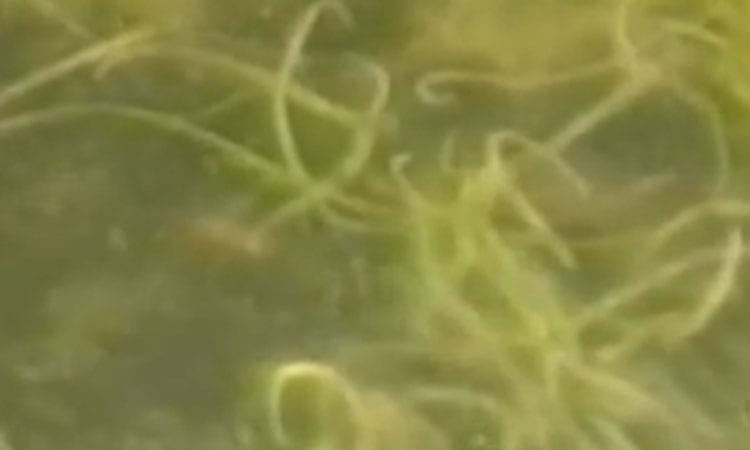- English Name: Mud Midget
- Latin Name: Wolffiella gladiata
- Life Cycle: Perennial
- Propagate: Mostly through buds, also by seeds
- States Affected: Common across the United States
- Dangers: Blocks sunlight from submerged vegetation, looks dirty and unsightly, disrupts fishing and recreational use of the water.
- Control Methods: Nets, Rakes, Removal tools, Deskuzzer, Lake Water Blanket
Floating Small Invasive lake Weed
A small rootless water weeds that floats on the surface of water, and has leaves that are not really leaves because they take in nutrients directly from the water. The correct botany-speak word for these strange leaves is thallus. Some people also refer to the thallus as fronds.
As the name suggests, the Mud Midget is a tiny weed with thallus that is typically no more than 1.5 meter wide and 9 mm long. That is in fact the first distinctive feature of the Wolffiella Gladiata: leaves that are thin and long, in the shape of a sickle. All the other similarly tiny weeds have either roundish or oval leaves. In addition, these peculiar leaves tend to grow in star-shaped bunches. That too is a distinctive feature that differentiates them from other small weeds.
The Life of a Wolffiella Gladiata Weed
Besides the star-look and the long leaves, the mud midget spends its life pretty much like other small weeds of the Duckweed family. It prefers stagnant or very slow-moving water, which means it is common in ponds, dugouts, shallow edges of lakes, slowly moving streams, ditches and marshes.
It also bears flowers but, as would be expected of such a small plant, the flowers are even tinier about half a mm long making it practically impossible to see them with the naked eye. But the weed does not rely primarily on seeds to reproduce. Rather, it produces mostly through buds, including winter buds that sink to the bottom of the water to wait for the new season. Like the Duckweeds, they are prolific parents able to double their population within as few as 36 hours.
Controlling the Spread of Mud Midget Weed
Again like the other duckweeds, the mud midget is a good source of food for aquatic animals and birds. Actually, besides wind and water currents, birds and animals are the main dispersers of mud midget to new territories. The weed is also used as animal feed, in part because it has very high protein content.
The weeds first growth rate, however, means that it is often a nuisance weed. A mat of these tiny plants also tends to look unsightly on water, more like a layer of pollution or algae that makes it difficult to fish or swim in the water. Where that problem arises and the weeds have to be contained, the normal method is to use rakes or other implements that can drag the weed to the banks. One of our weed control products, the Deskuzzer, is particularly effective in that task, because it has a long reach that allows one person to cover a wide area of the water from one position. The Deskuzzer is a 5 foot wide floating seine with sturdy abrasion, ultra tough screen, and a 24 foot pull line.
If, however, the intention is to totally eradicate the weed, physical dragging to the banks is never effective because parts of the weed invariably remain behind to start a new generation of weeds. It’s better, in such circumstances, to deploy the Lake Bottom Blanket. This is our lead weed control product made of 10 feet wide sheet of formulated polythene. The sheet is made of material that is lighter than water, enabling it to be weighed down into the water without reaching the bottom. The Lake Bottom Blanket works by blocking out sunlight to the mass of weeds pinned in the water. All the while, fish and other aquatic animals can freely swim below and above the Blanket.

